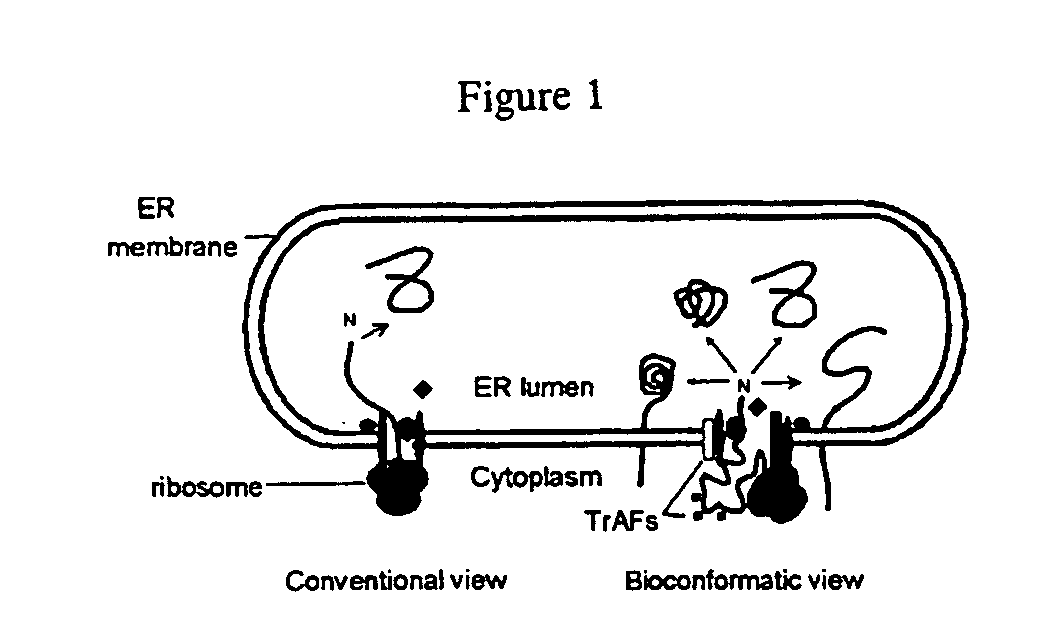Prostate cancer therapeutics and diagnostics based on conformers of prostatic cid phosphatase
a prostatic cid phosphatase and conformer technology, applied in the field of biological models and therapeutics for prostate cancer, can solve problems such as unreliable tests, and achieve the effect of maintaining androgen sensitivity
- Summary
- Abstract
- Description
- Claims
- Application Information
AI Technical Summary
Benefits of technology
Problems solved by technology
Method used
Image
Examples
example 1
Evidence for Conformers of pacp
[0038] The purpose of this study was to determine whether conformers of pacp can be produced. There are at least two different ways in which conformer choice is regulated during protein biogenesis. First, PrP was found to utilize open versus closed r-mjs to achieve its alternate conformational fates (that happen to differ also in topology thereby making them relatively easier to detect). Second, it was found that mutations of the prolactin signal sequence which had no effect on targeting or translocation per se were able to redirect prolactin biogenesis from one conformer to another (as assessed by utilization of an engineered glycosylation site) without affecting the nature of the ribosome-membrane junction (Rutkowski, D. T., et al. (2003) J. Biol. Chem. 278(32):30365-30372). The N and H domains of the signal sequence were found to be sufficient to confer these features (Rutkowski, D. T., et al. (2003) J. Biol. Chem. 278(32):30365-30372). In an attem...
example 2
Evaluation of Trafficking of pacp Synthesized Behind Different Signal Sequences
[0040] The purpose of this study is to determine if pacp synthesized behind different signal sequences and shown (see Example 1 above) to display different patterns of glycosylation, displays differences in trafficking (e.g. is retained in an intracellular compartment as opposed to being secreted). If so, this would be strong support that the different conformers defined by glycosylation pattern are relevant to the provocative intracellular distribution difference in pacp in normal prostate cells as compared to some transformed prostate cancer cell lines.
[0041] Signal sequences have been defined as being of different classes based on the ability of some of them to redirect the biogenesis of several unrelated proteins in a distinctive fashion, even though all of them are equally and fully competent to achieve translocation to the ER lumen. The distinctive features specific for a given class of signal seq...
example 3
Evaluation of Whether One of More Individual pacp Conformers are Responpsible for Conferring Androgen Dependence on Prostate Cancer Cells
[0045] The purpose of these experiments is to determine if some but not other pacp conformers (defined either by glycosylation pattern as described in Example 1 above or by intracellular distribution as described in Example 2, above) are able to entrain, in an androgen-dependent manner, the growth of a prostate cancer cell line that displays androgen independence in the absence of pacp expression, i.e. will some but not all pacp conformers have the same or at least a similar effect to that observed with wild-type pacp transfection. Wild-type pacp transfection into a LNCAP C-81 prostate cancer cell line renders the cell line androgen-sensitive. Wild-type pacp, by analogy to proteins studied previously (Hegde R. S., et al. (1998) Science. 279: 827-834, Rutkowski, D. T., et al. (2003) J. Biol. Chem. 278(32):30365-30372), represents a heterogeneous mi...
PUM
| Property | Measurement | Unit |
|---|---|---|
| Composition | aaaaa | aaaaa |
| Conformation | aaaaa | aaaaa |
Abstract
Description
Claims
Application Information
 Login to View More
Login to View More - R&D
- Intellectual Property
- Life Sciences
- Materials
- Tech Scout
- Unparalleled Data Quality
- Higher Quality Content
- 60% Fewer Hallucinations
Browse by: Latest US Patents, China's latest patents, Technical Efficacy Thesaurus, Application Domain, Technology Topic, Popular Technical Reports.
© 2025 PatSnap. All rights reserved.Legal|Privacy policy|Modern Slavery Act Transparency Statement|Sitemap|About US| Contact US: help@patsnap.com



